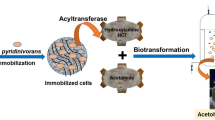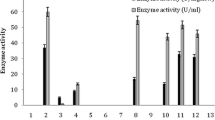Abstract
The nitrile hydratase (Nhase) induced cells of Rhodococcus rhodochrous PA-34 catalyzed the conversion of acrylonitrile to acrylamide. The cells of R. rhodochrous PA-34 immobilized in 2% (w/v) agar (1.76 mg dcw/ml agar matrix) exhibited maximum Nhase activity (8.25 U/mg dcw) for conversion of acrylonitrile to acrylamide at 10°C in the reaction mixture containing 0.1 M potassium phosphate buffer (pH 7.5), 8% (w/v) acrylonitrile and immobilized cells equivalent to 1.12 mg dcw (dry cell weight) per ml. In a partitioned fed batch reaction at 10°C, using 1.12 g dcw immobilized cells in a final volume of 1 l, a total of 372 g of acrylonitrile was completely hydrated to acrylamide (498 g) in 24 h. From the above reaction mixture 87% acrylamide (432 g) was recovered through crystallization at 4°C. By recycling the immobilized biocatalyst (six times), a total of 2,115 g acrylamide was produced.







Similar content being viewed by others
References
Andhale MS, Hamde VS (1996) Isolation and screening of acrylamide producing microorganisms. Ind J Exp Biol 34:1005–1009
Barbotin JN, Nava-Saucedo JE (1998) Bioencapsulation of living cells by entrapment in polysaccharide gels. In: Polysaccharides—structural diversity and functional versality. Marcel Dekker, New York, pp 750–751
Bernet N, Thiery A, Maestracci M, Arnaud A, Rios GM, Galzy P (1987) Continuous immobilized cell reactor for amide hydrolysis. J Ind Microbiol 2:129–136
Bui K, Arnaud A, Galzy P (1982) A new method to prepare amides by bioconversion of corresponding nitriles. Enzyme Microb Technol 4:195–197
Chang NH, Choi KS, Lee CY (1993) Bench scale production of acrylamide using resting cells of Brevibacterium sp. CH2 in a fed batch reactor. Enzyme Microb Technol 15:979–984
Chaplin MF, Bucke C (1990) Enzyme technology. Cambridge University Press, London
Fradet H, Arnaud A, Rios G, Galzy P (1985) Hydration of nitriles using a bacterial nitrile-hydratase immobilized on DEAE-cellulose. Biotechnol Bioeng XXVII:1581–1585
Graham D, Pereira R, Varfield D, Cowan D (2000) Nitrile transformation using free and immobilized cells of thermophilic Bacillus sp Enzyme Microb Technol 26:368–373
Hijort CM, Godtfredsen SE, Emborg C (1990) Isolation and characterization of nitrile hydratase from Rhodococcus sp J Chem Tech Biotechnol 48:217–226
Jallageas JC, Arnaud A, Galzy P (1980) Bioconversion of nitriles and their applications. Adv Biochem Engg 14:1–32
Kierstan MPJ, Coughlan MP (1985) Immobilization of cells and enzymes by gel entrapment. In: Immobilized cells and enzymes—a practical approach. IRL, Oxford, pp 43–45
Lee CY, Hwang YB, Chang HN (1991) Acrylonitrile adaptation of Brevibacterium sp. CH1 for acrylamide production. Enzyme Microb Technol 13:53–58
Maxwell GR (2004) Synthetic nitrogen products: a practical guide to the products and processes. Springer, Heidelberg, pp 395–396
Mersinger LJ, Hann EC, Cooling FB, Gavagan JE, Bassat AB, Wu S, Petrillo KL, Payne MS, Di-Cosimo R (2005) Production of acrylamide using alginate immobilized E. coli expressing Comamonas testosteroni 5- MGAM-4D nitrile hydratase. Adv Synth Catal 347:1125–1131
Mitsubishi Rayon (2001) Enzymatic production of acrylamide. In: The application of biotechnology to industrial sustainability. OCED, France, pp 71–75
Nagasawa T, Shimizu H, Yamada H (1993) The superiority of the third-generation catalyst, Rhodococcus rhodochrous J1 nitrile hydratase, for industrial production of acrylamide. Appl Microbiol Biotechnol 40:189–195
Raj J, Prasad S, Bhalla TC (2006) Rhodococcus rhodochrous PA-34 a potential catalyst for acrylamide synthesis. Process Biochem 41:1359–1363
Yamada H, Kobayashi M (1996) Nitrile hydratase and its application to industrial production of acrylamide. Biosci Biotech Biochem 60:1391–1400
Acknowledgments
We acknowledge the financial support in the form of Senior Research Fellowship from University Grants Commission (UGC), New Delhi, India to Mr. Jog Raj, from the Council and Scientific and Industrial Research (CSIR) to Mr. Nitya Nand Sharma and from the Department of Biotechnology, Government of India, New Delhi to Mr. Shreenath Prasad. The computational facility availed at Bioinformatics Centre, H. P. University is gratefully acknowledge.
Author information
Authors and Affiliations
Corresponding author
Rights and permissions
About this article
Cite this article
Raj, J., Sharma, N.N., Prasad, S. et al. Acrylamide synthesis using agar entrapped cells of Rhodococcus rhodochrous PA-34 in a partitioned fed batch reactor. J Ind Microbiol Biotechnol 35, 35–40 (2008). https://doi.org/10.1007/s10295-007-0263-z
Received:
Accepted:
Published:
Issue Date:
DOI: https://doi.org/10.1007/s10295-007-0263-z




